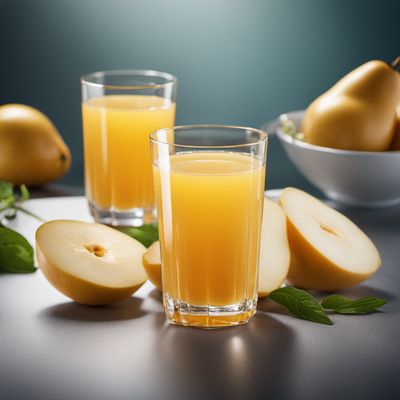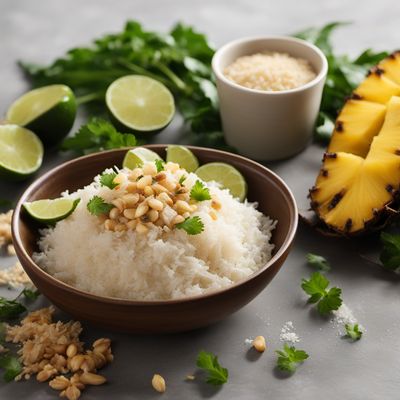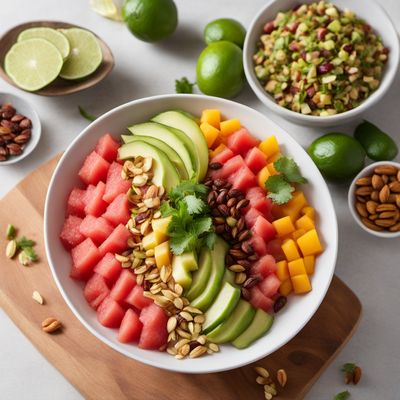
Ingredient
Juice, lime
The Zesty Elixir
Lime juice, extracted from the small green citrus fruit known as the lime, is a tart and acidic liquid that is commonly used as a flavoring agent in cooking, baking, and mixology. It has a bright and zesty taste, with a hint of sweetness, and its vibrant green color adds visual appeal to dishes. Lime juice is a versatile ingredient that can be used in both savory and sweet recipes, making it a staple in many cuisines around the world.
Origins and history
Limes are believed to have originated in Southeast Asia and have been cultivated for thousands of years. They were introduced to Europe by Arab traders during the Middle Ages and later brought to the Americas by Spanish explorers. Today, limes are grown in tropical and subtropical regions worldwide, with Mexico, India, and Egypt being major producers. Lime juice is a popular ingredient in Mexican, Thai, Indian, and Caribbean cuisines, where it is used to enhance the flavors of dishes and beverages.
Nutritional information
Lime juice is a good source of vitamin C, a powerful antioxidant that supports immune function and collagen production. It also contains small amounts of other vitamins and minerals, including potassium and folate. However, it is important to note that lime juice is acidic and should be consumed in moderation to avoid potential dental enamel erosion or digestive discomfort.
Allergens
Lime juice may cause allergic reactions in individuals with citrus allergies. It can also interact with certain medications, so it is advisable to consult a healthcare professional if you have any concerns.
How to select
When selecting lime juice, opt for freshly squeezed juice whenever possible, as it offers the best flavor and quality. Look for limes that are firm, glossy, and heavy for their size. Avoid limes with soft spots, blemishes, or signs of mold. To extract the juice, roll the lime on a hard surface to loosen the juice, then cut it in half and squeeze out the juice using a citrus juicer or by hand.
Storage recommendations
To prolong the freshness of lime juice, store it in a tightly sealed container in the refrigerator. It is best to use freshly squeezed lime juice within a few days, as its flavor and nutritional content may deteriorate over time.
How to produce
Limes can be grown at home in containers or in regions with a suitable climate. They require well-draining soil, plenty of sunlight, and regular watering. However, it may take several years for a lime tree to bear fruit, so patience is key.
Preparation tips
Lime juice is commonly used as a marinade or dressing for salads, seafood, and grilled meats. It is a key ingredient in popular dishes like ceviche, guacamole, and key lime pie. Lime juice is also a versatile addition to beverages, including cocktails, mocktails, and refreshing summer drinks.
Substitutions
Lemon juice can be used as a substitute for lime juice in most recipes, although it will impart a slightly different flavor. Additionally, lime zest can be used as a substitute for lime juice in certain recipes, such as adding a citrusy aroma to baked goods or garnishing dishes.
Culinary uses
Lime juice is widely used in various cuisines around the world. It is commonly found in Mexican, Thai, Indian, and Caribbean dishes, where it adds a tangy and refreshing element to salsas, curries, stir-fries, and beverages. Lime juice is also a popular ingredient in cocktails, such as margaritas and mojitos.
Availability
Limes are cultivated in tropical and subtropical regions worldwide, including Mexico, India, Egypt, Brazil, and the United States (Florida and California).
More ingredients from this category » Browse all

Juice, red currant
Tangy Elixir: Unleash the Vibrant Flavors of Red Currant

Juice, elderberry
The Immunity Booster

Juice, prune
The Sweet and Tangy Elixir of Prune Juice

Juice, grape
The Liquid Jewel

Juice, citrus
The Zesty Elixir

Juice, apple
The Essence of Nature: Exploring the Refreshing Apple Juice

Mixed fruit juice
"Fruit Fusion Delight: A Symphony of Flavors in Mixed Fruit Juice"

Juice, grapefruit
Tangy Citrus Burst

Juice, orange
"The Zesty Elixir: Unleashing the Vibrant Flavors of Freshly Squeezed Orange Juice"

Juice, passion fruit
The Tropical Elixir

Juice, pear
The Refreshing Elixir of Pear

Juice, pineapple
Tropical Elixir
Recipes using Juice, lime » Browse all

Roasted Lamb with Chilean Flair
Savory Chilean Roasted Lamb: A Taste of Tradition

Indonesian Chinese Style Sopa Leão Veloso
Spicy and Fragrant Indonesian Chinese Sopa

Vietnamese-style Hot Pot
Phở Hot Pot: A Vietnamese Twist on a Classic Chinese Dish

Caribbean Mango Chicken Stir-Fry
Tropical Delight Mango Chicken Stir-Fry

Antiguan Spiced Mashed Potatoes
Caribbean Delight: Antiguan Spiced Mashed Potatoes

Cajun-Inspired Spicy Seafood Ramen
Bayou Bliss: Cajun Spiced Seafood Ramen

Hawaiian-style Kalakukko
Tropical Delight: Hawaiian-style Kalakukko with a Twist

Anguillan-style Fregola with Conch
Caribbean Delight: Anguillan Fregola with Fresh Conch

Pyachysta - Savory Potato Pancakes with a Twist
Savory Potato Pancakes with a Latin American Twist

Mexican-style Chicken Satay
Sizzling Spicy Chicken Skewers with Zesty Mexican Flavors

Mexican-American Haft Mewa Salad
Fiesta Fruit Salad: A Mexican-American Twist on Haft Mewa

Hornado Pastuso with a Twist
Colombian Delight: Crispy Hornado Pastuso with a Flavorful Twist